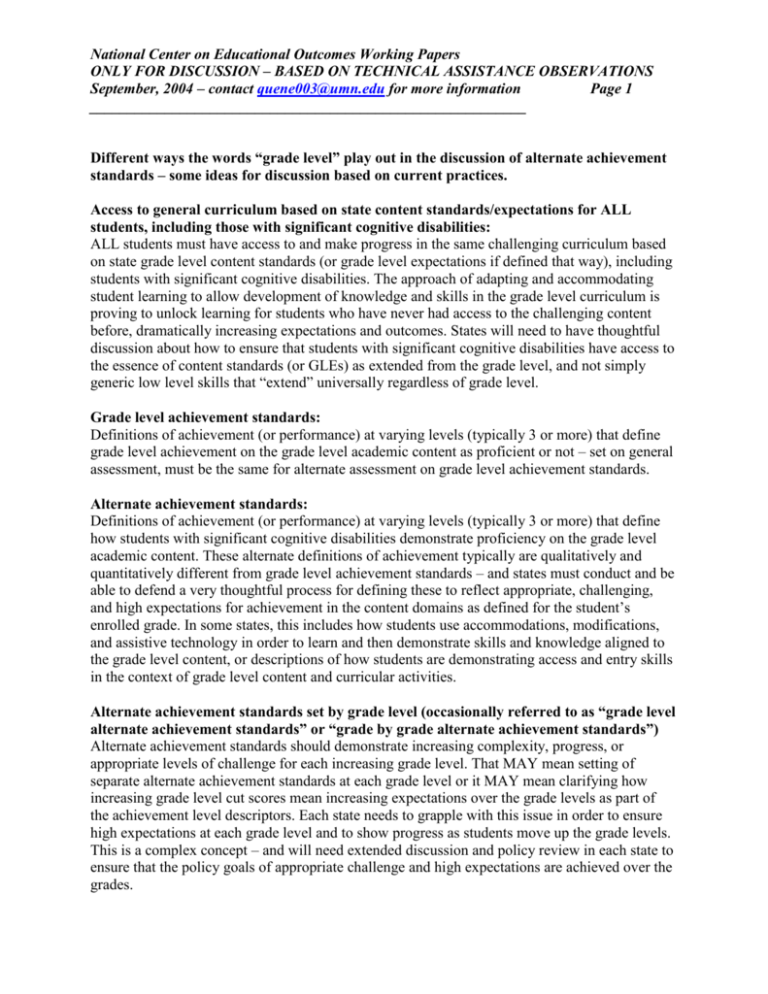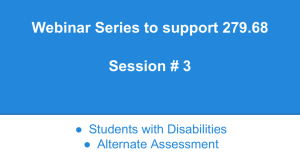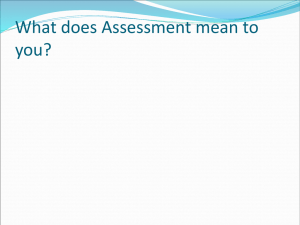Grade level achievement standards:
advertisement

National Center on Educational Outcomes Working Papers ONLY FOR DISCUSSION – BASED ON TECHNICAL ASSISTANCE OBSERVATIONS September, 2004 – contact quene003@umn.edu for more information Page 1 __________________________________________________________ Different ways the words “grade level” play out in the discussion of alternate achievement standards – some ideas for discussion based on current practices. Access to general curriculum based on state content standards/expectations for ALL students, including those with significant cognitive disabilities: ALL students must have access to and make progress in the same challenging curriculum based on state grade level content standards (or grade level expectations if defined that way), including students with significant cognitive disabilities. The approach of adapting and accommodating student learning to allow development of knowledge and skills in the grade level curriculum is proving to unlock learning for students who have never had access to the challenging content before, dramatically increasing expectations and outcomes. States will need to have thoughtful discussion about how to ensure that students with significant cognitive disabilities have access to the essence of content standards (or GLEs) as extended from the grade level, and not simply generic low level skills that “extend” universally regardless of grade level. Grade level achievement standards: Definitions of achievement (or performance) at varying levels (typically 3 or more) that define grade level achievement on the grade level academic content as proficient or not – set on general assessment, must be the same for alternate assessment on grade level achievement standards. Alternate achievement standards: Definitions of achievement (or performance) at varying levels (typically 3 or more) that define how students with significant cognitive disabilities demonstrate proficiency on the grade level academic content. These alternate definitions of achievement typically are qualitatively and quantitatively different from grade level achievement standards – and states must conduct and be able to defend a very thoughtful process for defining these to reflect appropriate, challenging, and high expectations for achievement in the content domains as defined for the student’s enrolled grade. In some states, this includes how students use accommodations, modifications, and assistive technology in order to learn and then demonstrate skills and knowledge aligned to the grade level content, or descriptions of how students are demonstrating access and entry skills in the context of grade level content and curricular activities. Alternate achievement standards set by grade level (occasionally referred to as “grade level alternate achievement standards” or “grade by grade alternate achievement standards”) Alternate achievement standards should demonstrate increasing complexity, progress, or appropriate levels of challenge for each increasing grade level. That MAY mean setting of separate alternate achievement standards at each grade level or it MAY mean clarifying how increasing grade level cut scores mean increasing expectations over the grade levels as part of the achievement level descriptors. Each state needs to grapple with this issue in order to ensure high expectations at each grade level and to show progress as students move up the grade levels. This is a complex concept – and will need extended discussion and policy review in each state to ensure that the policy goals of appropriate challenge and high expectations are achieved over the grades. National Center on Educational Outcomes Working Papers ONLY FOR DISCUSSION – BASED ON TECHNICAL ASSISTANCE OBSERVATIONS September, 2004 – contact quene003@umn.edu for more information Page 2 __________________________________________________________ All of this requires thoughtful discussion in a state of how students with significant cognitive disabilities access grade level content, and how they build and demonstrate proficiency on that content. If the state ensures alignment of alternate assessments to enrolled grade level content for every student, grade level content which by definition increases in complexity grade by grade, it will be easier to defend how the alternate achievement standards set on these alternate assessments also increase in complexity grade by grade. See attached citations from Title I Regulations defining academic content and achievement standards, July 5, 2002, and December 9, 2003. National Center on Educational Outcomes Working Papers ONLY FOR DISCUSSION – BASED ON TECHNICAL ASSISTANCE OBSERVATIONS September, 2004 – contact quene003@umn.edu for more information Page 3 __________________________________________________________ TWO CITATIONS FROM TITLE I REGULATIONS DEFINING ACADEMIC CONTENT AND ACHIEVEMENT STANDARDS: July 5, 2002 and December 9, 2003 [Federal Register: July 5, 2002 (Volume 67, Number 129)] [Rules and Regulations] [Page 45037-45047] From the Federal Register Online via GPO Access [wais.access.gpo.gov] [DOCID:fr05jy02-12] Sec. 200.1 State responsibilities for developing challenging academic standards. (a) Academic standards in general. A State must develop challenging academic content and student academic achievement standards that will be used by the State, its local educational agencies (LEAs), and its schools to carry out subpart A of this part. These academic standards must-(1) Be the same academic standards that the State applies to all public schools and public school students in the State, including the public schools and public school students served under subpart A of this part; (2) Include the same knowledge, skills, and levels of achievement expected of all students; and (3) Include at least mathematics, reading/language arts, and, beginning in the 2005-2006 school year, science, and may include other subjects determined by the State. (b) Academic content standards. (1) The challenging academic content standards required under paragraph (a) of this section must-(i) Specify what all students are expected to know and be able to do; (ii) Contain coherent and rigorous content; and (iii) Encourage the teaching of advanced skills. (2) A State's academic content standards may-(i) Be grade specific; or, (ii) Cover more than one grade if grade-level content expectations are provided for each of grades 3 through 8. (3) At the high school level, the academic content standards must define the knowledge and skills that all high school students are expected to know and be able to do in at least reading/language arts, mathematics, and, beginning in the 2005-06 school year, science, irrespective of course titles or years completed. (c) Academic achievement standards. (1) The challenging student academic achievement standards required under paragraph (a) of this section must-(i) Be aligned with the State's academic content standards; and (ii) Include the following components for each content area: (A) Achievement levels that describe at least-(1) Two levels of high achievement--proficient and advanced--that determine how well students are mastering the material in the State's academic content standards; and (2) A third level of achievement--basic--to provide complete information about the progress of lower-achieving students toward mastering the proficient and advanced levels of achievement. National Center on Educational Outcomes Working Papers ONLY FOR DISCUSSION – BASED ON TECHNICAL ASSISTANCE OBSERVATIONS September, 2004 – contact quene003@umn.edu for more information Page 4 __________________________________________________________ [[Page 45040]] (B) Descriptions of the competencies associated with each achievement level. (C) Assessment scores ("cut scores") that differentiate among the achievement levels as specified in paragraph (c)(1)(ii)(A) of this section, and a description of the rationale and procedures used to determine each achievement level. (2) A State must develop academic achievement standards for every grade and subject assessed, even if the State's academic content standards cover more than one grade. (3) With respect to academic achievement standards in science, a State must develop-(i) Achievement levels and descriptions no later than the 2005-06 school year; and (ii) Assessment scores ("cut scores") after the State has developed its science assessments but no later than the 2007-08 school year. (d) Subjects without standards. If an LEA serves students under subpart A of this part in subjects for which a State has not developed academic standards, the State must describe in its State plan a strategy for ensuring that those students are taught the same knowledge and skills and held to the same expectations in those subjects as are all other students. (e) Other subjects with standards. If a State has developed standards in other subjects for all students, the State must apply those standards to students participating under subpart A of this part. (Authority 20 U.S.C. 6311(b)(1)) (Approved by the Office of Management and Budget under control number 1810-0576) National Center on Educational Outcomes Working Papers ONLY FOR DISCUSSION – BASED ON TECHNICAL ASSISTANCE OBSERVATIONS September, 2004 – contact quene003@umn.edu for more information Page 5 __________________________________________________________ [Federal Register: December 9, 2003 (Volume 68, Number 236)] [Rules and Regulations] [Page 68697-68708] From the Federal Register Online via GPO Access [wais.access.gpo.gov] [DOCID:fr09de03-27] [[Page 68697]] The Secretary amends part 200 of title 34 of the Code of Federal Regulations as follows: PART 200--TITLE I--IMPROVING THE ACADEMIC ACHIEVEMENT OF THE DISADVANTAGED 0 1. The authority citation for part 200 continues to read as follows: Authority: 20 U.S.C. 6301 through 6578, unless otherwise noted. 0 2. In Sec. 200.1, revise paragraph (a)(1), redesignate paragraphs (d) and (e) as (e) and (f), and add new paragraph (d) to read as follows: Sec. 200.1 State responsibilities for developing challenging academic standards. (a) * * * (1) Be the same academic standards that the State applies to all public schools and public school students in the State, including the public schools and public school students served under subpart A of this part, except as provided in paragraph (d) of this section; * * * * * (d) Alternate academic achievement standards. For students under section 602(3) of the Individuals with Disabilities Education Act with the most significant cognitive disabilities who take an alternate assessment, a State may, through a documented and validated standardssetting process, define alternate academic achievement standards, provided those standards-(1) Are aligned with the State's academic content standards; (2) Promote access to the general curriculum; and (3) Reflect professional judgment of the highest achievement standards possible. * * * * * 0 3. In Sec. 200.6, revise paragraph (a)(2)(ii) and add new paragraph (a)(2)(iii) to read as follows: National Center on Educational Outcomes Working Papers ONLY FOR DISCUSSION – BASED ON TECHNICAL ASSISTANCE OBSERVATIONS September, 2004 – contact quene003@umn.edu for more information Page 6 __________________________________________________________ Sec. 200.6 Inclusion of all students. * * * * * (a) * * * (2) * * * (ii)(A) Alternate assessments must yield results for the grade in which the student is enrolled in at least reading/language arts, mathematics, and, beginning in the 2007-2008 school year, science, except as provided in the following paragraph. (B) For students with the most significant cognitive disabilities, alternate assessments may yield results that measure the achievement of those students relative to the alternate academic achievement standards the State has defined under Sec. 200.1(d). (iii) If a State permits the use of alternate assessments that yield results based on alternate academic achievement standards, the State must-(A)(1) Establish and ensure implementation of clear and appropriate guidelines for Individualized Educational Program (IEP) teams to apply in determining when a child's significant cognitive disability justifies assessment based on alternate academic achievement standards; and (2) Ensure that parents of those students are informed that their child's achievement will be based on alternate achievement standards; and (B) Report separately, under section 1111(h)(4) of the ESEA, the number and percentage of students with disabilities taking-(1) Alternate assessments based on the alternate academic achievement standards defined under Sec. 200.1(d); (2) Alternate assessments based on the academic achievement standards defined under Sec. 200.1(c); and [[Page 68703]] (3) Regular assessments, including those administered with appropriate accommodations. (C) Document that students with the most significant cognitive disabilities are, to the extent possible, included in the general curriculum and in assessments aligned with that curriculum; (D) Develop, disseminate information on, and promote use of appropriate accommodations to increase the number of students with the most significant cognitive disabilities who are tested against gradelevel academic achievement standards; and (E) Ensure that regular and special education teachers and other appropriate staff know how to administer assessments, including making appropriate use of accommodations, for students with the most significant cognitive disabilities. * * * * * 0 4. In Sec. 200.13, revise the introductory text of paragraph (b) and paragraph (b)(1), redesignate paragraph (c) as paragraph (d), and add new paragraph (c) to read as follows:







